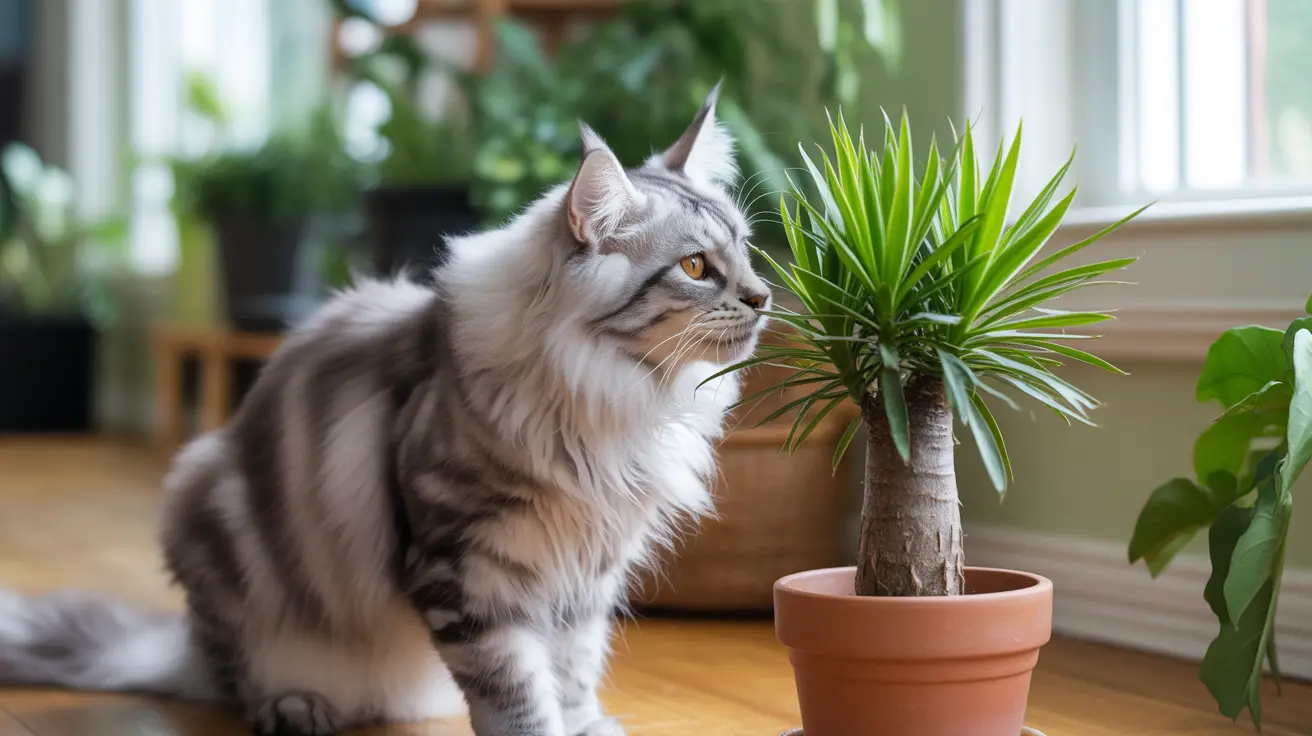Are Dragon Trees Toxic to Cats? A Complete Safety Guide for Cat Owners
As a cat owner who loves decorating your home with beautiful plants, you might wonder: are dragon trees toxic to cats? The short answer is yes – dragon trees (Dracaena species) contain toxic compounds called saponins that can cause serious health problems in cats. These popular houseplants, while stunning additions to any home décor, pose significant risks to our feline companions and require careful consideration before bringing them into a cat-friendly household.
Understanding the dangers of dragon tree toxicity is crucial for every responsible cat owner. From recognizing the early warning signs of poisoning to knowing what immediate steps to take in an emergency, this comprehensive guide will equip you with the knowledge needed to keep your beloved cat safe while still enjoying indoor plants. We'll explore safe alternatives, prevention strategies, and expert veterinary advice to help you create a beautiful yet secure environment for both you and your feline friend.
Understanding Dragon Tree Toxicity in Cats
Dragon trees and related Dracaena species contain saponins, naturally occurring toxic compounds that serve as the plant's defense mechanism against herbivores. These saponins are present throughout the plant, including the leaves, stems, and roots, making every part of the dragon tree potentially dangerous to cats. When cats ingest any portion of these plants, the saponins can cause immediate and sometimes severe toxic reactions.
The toxicity level can vary depending on the specific Dracaena species, with popular varieties like the Madagascar dragon tree (Dracaena marginata) and straight margined dracaena all containing similar concentrations of these harmful compounds. Due to their prevalence as houseplants and garden specimens, cats are frequently exposed to these toxic plants, making awareness of their dangers particularly important for pet owners.
Recognizing Symptoms of Dragon Tree Poisoning
If your cat has ingested any part of a dragon tree, symptoms typically appear shortly after consumption. The most common immediate signs include excessive drooling, vomiting, and diarrhea, which occur as the cat's body attempts to expel the toxic substances. These initial gastrointestinal symptoms are often accompanied by abdominal pain and a noticeable loss of appetite.
As the toxicity progresses, more serious neurological and cardiovascular symptoms may develop. Watch for signs of weakness, incoordination, and unsteady walking, which indicate the saponins are affecting your cat's nervous system. Additional warning signs include dilated pupils, depression, lethargy, rapid heartbeat, and staggering movements. These symptoms collectively point to systemic toxicity that requires immediate veterinary attention.
Severity Factors and Vulnerable Populations
The severity of dragon tree poisoning depends on several critical factors, including the amount of plant material ingested and your cat's individual health status. Young kittens, elderly cats, and those with pre-existing health conditions are particularly vulnerable to severe toxic reactions. Even small amounts of plant material can cause significant symptoms in these at-risk populations.
The good news is that dragon tree poisoning typically results in immediate but not long-term complications. The liver, kidneys, and gastrointestinal tract are generally not permanently damaged, and cats often recover fully with proper veterinary care and supportive treatment.
Emergency Response and First Aid
If you suspect your cat has eaten any part of a dragon tree, immediate action is crucial. First, remove any visible plant material from your cat's mouth and environment to prevent further ingestion. Do not attempt to induce vomiting at home, as this is not recommended without professional veterinary guidance and could potentially cause additional harm.
Contact your veterinarian immediately or call an emergency animal hospital if it's after hours. The ASPCA Poison Control and Pet Poison Helpline also provide valuable resources and emergency contact information for animal poisoning cases. When speaking with veterinary professionals, be prepared to provide details about the amount of plant consumed, the time of ingestion, and any symptoms your cat is currently experiencing.
Professional Veterinary Treatment
Veterinary treatment for dragon tree poisoning focuses on supportive care and symptom management. There is no specific antidote for saponin toxicity, so treatment typically involves intravenous or subcutaneous fluids to prevent dehydration caused by vomiting and excessive drooling. Anti-nausea medications and pain relief may also be administered to keep your cat comfortable during recovery.
Diagnosis is based on the history of plant ingestion and clinical examination of symptoms. Your veterinarian may perform blood tests to assess dehydration levels and electrolyte imbalances. In severe cases, hospitalization may be necessary to provide continuous monitoring and intensive supportive care until the toxins clear your cat's system.
Safe Plant Alternatives for Cat Owners
Rather than risking your cat's health with dragon trees, consider these beautiful and completely safe plant alternatives that can provide the same aesthetic appeal without the toxic dangers. Cat-safe options include spider plants, Boston ferns, prayer plants, and parlor palms, all of which offer attractive foliage and are non-toxic to felines.
For cat owners who want plants with similar architectural appeal to dragon trees, consider the ponytail palm or bamboo palm, both of which provide height and dramatic foliage without posing health risks. These alternatives allow you to maintain a lush, green indoor environment while prioritizing your cat's safety and well-being.
Prevention Strategies and Cat-Proofing Your Home
If you currently have dragon trees in your home, the safest approach is complete removal, especially if your cat shows persistent interest in chewing or investigating the plants. However, if you choose to keep these plants, they must be placed completely out of your cat's reach – and remember that cats are excellent climbers and jumpers, so "out of reach" means truly inaccessible locations.
Create an enriching indoor environment that reduces your cat's interest in potentially dangerous plants. Provide appropriate alternatives like cat grass, catnip, or cat-safe herbs that satisfy your pet's natural urge to nibble on greenery. Install scratching posts, puzzle feeders, and interactive toys near plant areas to redirect your cat's attention away from toxic specimens.
Ongoing Monitoring and Plant Safety
Regularly inspect your plants and promptly remove any fallen leaves or debris from the environment, as even small amounts of plant material on the floor can pose risks. Monitor your cat for any unusual symptoms such as vomiting, drooling, lethargy, or changes in behavior, especially if you suspect they may have accessed plants in your home.
Consider creating designated plant areas that are completely off-limits to your cat, using physical barriers or deterrents to maintain separation. Remember that cats are naturally curious creatures, and their safety should always take priority over decorative plant choices.
Recovery and Long-Term Care
Fortunately, symptoms of dragon tree poisoning generally resolve within 24 hours after all plant material has passed through your cat's system. No lasting damage or deaths have been widely reported due to dragon tree ingestion, making the prognosis generally favorable with appropriate veterinary care.
During recovery, provide your cat with tender loving care in a calm, comfortable environment. Monitor their hydration status and ensure they're eating and eliminating normally. Maintain regular follow-up appointments with your veterinarian to ensure complete recovery and address any lingering concerns about your cat's health.
Frequently Asked Questions
- How quickly do symptoms appear after a cat eats a dragon tree?
Symptoms typically appear shortly after ingestion, often within the first few hours. The most common initial signs include drooling, vomiting, and diarrhea as the cat's body reacts to the toxic saponins in the plant.
- Can a cat die from eating a dragon tree?
While dragon tree poisoning can cause serious symptoms, no lasting damage or deaths have been widely reported from ingestion of these plants. However, immediate veterinary care is still crucial to manage symptoms and prevent complications.
- What should I do if my cat ate dragon tree leaves?
Remove any remaining plant material from your cat's mouth and environment, then contact your veterinarian immediately. Do not induce vomiting without professional guidance, and monitor your cat closely for symptoms while seeking professional care.
- Are all Dracaena species toxic to cats?
Yes, all Dracaena species, including the Madagascar dragon tree (Dracaena marginata) and straight margined dracaena, contain saponins and pose similar toxic risks to cats. The entire plant family should be considered dangerous for feline companions.
- How long does it take for a cat to recover from dragon tree poisoning?
With proper veterinary care, symptoms generally resolve within 24 hours after all plant material has passed through the cat's system. Most cats recover fully without long-term complications when treated promptly and appropriately.
- What other common houseplants are toxic to cats?
Many popular houseplants are toxic to cats, including aloe, asparagus fern, corn plant, dieffenbachia, elephant ear, various lilies, cyclamen, heartleaf philodendron, jade plant, satin pothos, and mistletoe cactus. Always research plant safety before bringing new specimens into a cat-friendly home.
- Is it safe to keep dragon trees if I put them in high places?
While elevating plants reduces risk, it doesn't eliminate it entirely. Cats are excellent climbers and jumpers, and fallen leaves or debris can still pose dangers. The safest approach is choosing cat-safe plant alternatives rather than relying solely on placement strategies.
Conclusion
Understanding that dragon trees are toxic to cats is essential knowledge for any responsible pet owner who wants to maintain a safe home environment. While these beautiful plants may be tempting additions to your indoor décor, the potential health risks to your feline companion far outweigh their aesthetic benefits. The saponins found in all Dracaena species can cause immediate and serious symptoms ranging from gastrointestinal distress to neurological complications.
By choosing cat-safe plant alternatives and implementing proper prevention strategies, you can create a beautiful, plant-filled home that poses no risks to your beloved pet. Remember that your cat's health and safety should always be the top priority, and when in doubt, consult with your veterinarian about plant choices and emergency procedures. With the right knowledge and precautions, you can successfully balance your love of plants with your responsibility as a caring cat owner.






